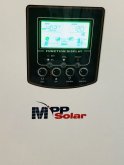Donald Siegel
New Member
- Joined
- Sep 24, 2019
- Messages
- 78
I live in the desert and wanted a be able to run a small one room portable AC at 900 watts continuously during a power outage. I pretty much used Will’s videos to guide me all the way. MppSolar 24v all-in-one, Daly BMS, 80 amp circuit breaker to the battery, lifepo4 100 ampHour Chinese sourced cells 8 in series, 30 amp Bussmann breaker to the panels with an on/off switch, 4-used 250 Watt panels in series from SanTan Solar ($50 each), Victron battery protect set to program 8. It works great on battery alone before I got the panels a get close to 3-hours of AC, with a solar assist to be determined.
Attachments
Last edited by a moderator:





